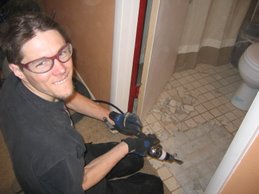(some of the major points from the Thursday assignment)
Why Help?
- I am looking at a exploring the possibility of introducing a homeless "city" into Las Vegas
- How can I look at the model of this homeless city in Portland, OR. and implement the principles and goals of their community into Las Vegas, NV?
- A place with rules without the social mandates of the city homeless shelters?
- Provide a sense of belonging... a fresh introduction back into the main stream "society". A sort of "halfway" house/place for the "bums", "vagrants", "undesirables", etc...
- implement the Portland model into the Vegas Valley
- re"architect" the components that I see as "Hurdles" in the process of assisting a process for a communal distortion of "RECIPROCITY"
FORESEEN ISSUES:
- Location
- Value
- Participation
- Favor/support/interest
- Education
- City ordinances
Karrick wrote:
- Overarching goal is the Architect not only as designer, but a mediator of social differences
- What makes "undesirable"? What makes transitional? What is the root problem? Many studies have been done on the homeless (in) D.C. in the late 70's? bought homeless people bus tickets to anywhere they wanted to go. Can a shanty town be desirable? What other buildings house the homeless. Search Single residential Occupancy (SRO) - Chicago, Columbus. The commons at grant.
Anne wrote:
- How could you (I) involve others like you (me) in the process? You could even improve on the model in Portland by involving the community as a whole: fundraising and volunteering. It would be key to get businesses, educators, etc on board. Can you (I) teach those who want to learn? Yes. Can people who want to work, work? Yes. How could you (I) convince others to take a chance on these people's future? How can you (I) began to educate people about the benefits of helping others.
How?
1.23.2007
History/Theory - Week 3 .... 4
Posted by
Ken Ballard
at
8:35 PM
![]()
Labels: History/Theory
Subscribe to:
Post Comments (Atom)
Fun Links
- The American Institute of Architects
- AIA Las Vegas
- Suzana Rutar, Architect
- IECC COMcheck-web
- LA Dodgers
- Things to read
- Drivers, start your engines...
- Science is COOL!!!
- The City Tower
- Slovenian World Confrence - Architects and Builders from Slovenia and the World
- architectural studies library UNLV
- ASL Blog
- UNLV Bridge Studio


















5 comments:
Ken,
I am going to start looking for case studies regarding my issue. Do you have any pictures from Portland? Will you focus on the social or architectural component of this issue? It's something I am tossing around myself. The architectural portion may seem less important/critical to the project's implementation, but it is our area of expertise.
Ken,
How is the home improvement project going. Your wife still making you look bad? Ha Ha.
Anyway, perhaps the idea of home improvements could help the cause. Show the public and the homeless that they are worth investing in, by integrating them into the design process and work force to implement their own built environment. By giving them a sense of self worth you may show some the path back into society should they be looking for it; as well as showing society that the homeless can hold themselves accountable. This will provide a challenge to you as a designer to develop a kit of parts that is "Apple-like" and user friendly. Perhaps you can tie it into the green movement by promoting donated recyclable materials. Perhaps, we could convince LEED to provide additiona credits towards certification should a contractor contribute the recyclable materials from their demolition site to such a cause. What do you think?
The problem raises an interesting side problem, which may be bigger. The model you're looking at offers the ability for self-governance, which is a fabulous idea. But there are two underlying (and closely related) principles that you'll need to address for yourself.
1. To what extent should small groups of people -- neighborhood associations, for instance -- be able to "remove themselves" from common governance and shared responsibility? That's one of Bickford's central concerns, and you can make a lot of mileage by using or arguing back against her thinking.
2. The common language here is "a fresh introduction back into the mainstream..." But aside from economic misfortune, one of the reasons people become social misfits is because they never accepted the "mainstream" as a culture that they aspired to be part of. To what extent does your definition of success rely on turnover -- that is, people entering, recovering and leaving -- and to what extent could you argue success if someone decided to live out the rest of their lives there?
Ken,
I heard an alarming story on the local news two nights ago. The temperatures here dropped into the teens overnight and a group of volunteers were scouring the streets of Columbus looking for homeless people in order to provide them temporary shelter within the homes of the volunteers. Per the stats from last year there are over 1400 homeless in Columbus and on nights like Tuesday night, on average 200 of them choose not to go to public shelters that are available.
I don't think sucess is necessarily measured by having all of the homeless back into mainstream society. Some people live the "gypsy life" by choice. But sucess could be measured to some degree by having everyone in a warm place on cold nights.
Post a Comment